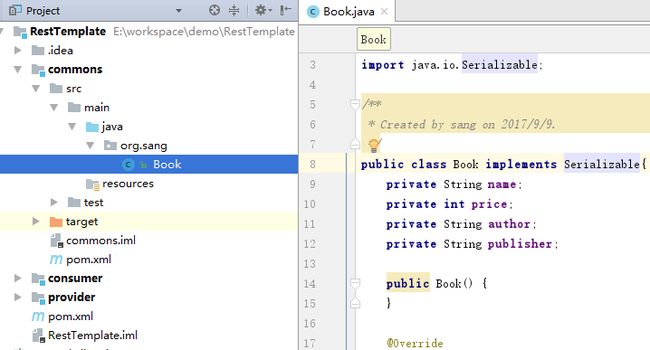Spring RestTemplate中GET/ POST/ PUT/ DELETE请求方式
最近要是用RestTemplate做一些操作,这里记录一下。
在Spring Cloud中服务的发现与消费一文中,当我们从服务消费端去调用服务提供者的服务的时候,使用了一个很好用的对象,叫做RestTemplate,当时我们只使用了RestTemplate中最简单的一个功能getForEntity发起了一个get请求去调用服务端的数据,同时,我们还通过配置@LoadBalanced注解开启客户端负载均衡,RestTemplate的功能不可谓不强大,那么今天我们就来详细的看一下RestTemplate中几种常见请求方法的使用。
本文是Spring Cloud系列的第六篇文章,了解前五篇文章的内容有助于更好的理解本文:
1.使用Spring Cloud搭建服务注册中心
2.使用Spring Cloud搭建高可用服务注册中心
3.Spring Cloud中服务的发现与消费
4.Eureka中的核心概念
5.什么是客户端负载均衡
本文主要从以下四个方面来看RestTemplate的使用:
- GET请求
- POST请求
- PUT请求
- DELETE请求
OK,开始吧。
环境搭建
首先我们要搭建一个测试环境,方便我们一会验证相应的API。
服务注册中心我就直接使用前文(使用Spring Cloud搭建服务注册中心)中创建的服务注册中心。
服务提供者和服务消费者我创建在一个maven工程中,如果小伙伴对IntelliJ IDEA中创建maven多模块项目还不了解的话,可以参考IntelliJ IDEA中创建Web聚合项目(Maven多模块项目)。创建好的maven项目如下图所示:
其中commons是一个公共模块,是一个普通的JavaSE工程,我们一会主要将实体类写在这个模块中,provider和consumer是两个spring boot项目,provider将扮演服务提供者的角色,consumer扮演服务消费者的角色。
commons模块主要用来提供实体类,内容如下:

然后在provider和consumer模块中添加对commons的依赖,依赖代码如下:
org.sang
commons
1.0-SNAPSHOT
provider和consumer的开发小伙伴们可以参考使用Spring Cloud搭建服务注册中心和Spring Cloud中服务的发现与消费,我这里就不再赘述了。下文中我只列出provider和consumer的核心代码,文末可以下载源码。
GET请求
在RestTemplate中,发送一个GET请求,我们可以通过如下两种方式:
第一种:getForEntity
getForEntity方法的返回值是一个ResponseEntity,ResponseEntity是Spring对HTTP请求响应的封装,包括了几个重要的元素,如响应码、contentType、contentLength、响应消息体等。比如下面一个例子:
@RequestMapping("/gethello")
public String getHello() {
ResponseEntity responseEntity = restTemplate.getForEntity("http://HELLO-SERVICE/hello", String.class);
String body = responseEntity.getBody();
HttpStatus statusCode = responseEntity.getStatusCode();
int statusCodeValue = responseEntity.getStatusCodeValue();
HttpHeaders headers = responseEntity.getHeaders();
StringBuffer result = new StringBuffer();
result.append("responseEntity.getBody():").append(body).append("
")
.append("responseEntity.getStatusCode():").append(statusCode).append("
")
.append("responseEntity.getStatusCodeValue():").append(statusCodeValue).append("
")
.append("responseEntity.getHeaders():").append(headers).append("
");
return result.toString();
} 关于这段代码,我说如下几点:
- getForEntity的第一个参数为我要调用的服务的地址,这里我调用了服务提供者提供的/hello接口,注意这里是通过服务名调用而不是服务地址,如果写成服务地址就没法实现客户端负载均衡了。
- getForEntity第二个参数String.class表示我希望返回的body类型是String
- 拿到返回结果之后,将返回结果遍历打印出来
最终显示结果如下:
有时候我在调用服务提供者提供的接口时,可能需要传递参数,有两种不同的方式,如下:
@RequestMapping("/sayhello")
public String sayHello() {
ResponseEntity responseEntity = restTemplate.getForEntity("http://HELLO-SERVICE/sayhello?name={1}", String.class, "张三");
return responseEntity.getBody();
}
@RequestMapping("/sayhello2")
public String sayHello2() {
Map map = new HashMap<>();
map.put("name", "李四");
ResponseEntity responseEntity = restTemplate.getForEntity("http://HELLO-SERVICE/sayhello?name={name}", String.class, map);
return responseEntity.getBody();
} - 可以用一个数字做占位符,最后是一个可变长度的参数,来一一替换前面的占位符
- 也可以前面使用name={name}这种形式,最后一个参数是一个map,map的key即为前边占位符的名字,map的value为参数值
第一个调用地址也可以是一个URI而不是字符串,这个时候我们构建一个URI即可,参数神马的都包含在URI中了,如下:
@RequestMapping("/sayhello3")
public String sayHello3() {
UriComponents uriComponents = UriComponentsBuilder.fromUriString("http://HELLO-SERVICE/sayhello?name={name}").build().expand("王五").encode();
URI uri = uriComponents.toUri();
ResponseEntity responseEntity = restTemplate.getForEntity(uri, String.class);
return responseEntity.getBody();
} 通过Spring中提供的UriComponents来构建Uri即可。
当然,服务提供者不仅可以返回String,也可以返回一个自定义类型的对象,比如我的服务提供者中有如下方法:
@RequestMapping(value = "/getbook1", method = RequestMethod.GET)
public Book book1() {
return new Book("三国演义", 90, "罗贯中", "花城出版社");
}对于该方法我可以在服务消费者中通过如下方式来调用:
@RequestMapping("/book1")
public Book book1() {
ResponseEntity responseEntity = restTemplate.getForEntity("http://HELLO-SERVICE/getbook1", Book.class);
return responseEntity.getBody();
} 运行结果如下:
第二种:getForObject
getForObject函数实际上是对getForEntity函数的进一步封装,如果你只关注返回的消息体的内容,对其他信息都不关注,此时可以使用getForObject,举一个简单的例子,如下:
@RequestMapping("/book2")
public Book book2() {
Book book = restTemplate.getForObject("http://HELLO-SERVICE/getbook1", Book.class);
return book;
}getForObject也有几个重载方法,如下:
这几个重载方法参数的含义和getForEntity一致,我就不再赘述了。
POST请求
在RestTemplate中,POST请求可以通过如下三个方法来发起:
第一种:postForEntity
该方法和get请求中的getForEntity方法类似,如下例子:
@RequestMapping("/book3")
public Book book3() {
Book book = new Book();
book.setName("红楼梦");
ResponseEntity responseEntity = restTemplate.postForEntity("http://HELLO-SERVICE/getbook2", book, Book.class);
return responseEntity.getBody();
} - 方法的第一参数表示要调用的服务的地址
- 方法的第二个参数表示上传的参数
- 方法的第三个参数表示返回的消息体的数据类型
我这里创建了一个Book对象,这个Book对象只有name属性有值,将之传递到服务提供者那里去,服务提供者代码如下:
@RequestMapping(value = "/getbook2", method = RequestMethod.POST)
public Book book2(@RequestBody Book book) {
System.out.println(book.getName());
book.setPrice(33);
book.setAuthor("曹雪芹");
book.setPublisher("人民文学出版社");
return book;
}服务提供者接收到服务消费者传来的参数book,给其他属性设置上值再返回,调用结果如下:
postForEntity的其他重载方法如下:
这些方法的参数含义和getForEntity参数的含义一致,不再赘述。
第二种:postForObject
如果你只关注,返回的消息体,可以直接使用postForObject。用法和getForObject一致。
第三种:postForLocation
postForLocation也是提交新资源,提交成功之后,返回新资源的URI,postForLocation的参数和前面两种的参数基本一致,只不过该方法的返回值为Uri,这个只需要服务提供者返回一个Uri即可,该Uri表示新资源的位置。
PUT请求
在RestTemplate中,PUT请求可以通过put方法调用,put方法的参数和前面介绍的postForEntity方法的参数基本一致,只是put方法没有返回值而已。举一个简单的例子,如下:
@RequestMapping("/put")
public void put() {
Book book = new Book();
book.setName("红楼梦");
restTemplate.put("http://HELLO-SERVICE/getbook3/{1}", book, 99);
}book对象是我要提交的参数,最后的99用来替换前面的占位符{1}
DELETE请求
delete请求我们可以通过delete方法调用来实现,如下例子:
@RequestMapping("/delete")
public void delete() {
restTemplate.delete("http://HELLO-SERVICE/getbook4/{1}", 100);
}delete方法也有几个重载的方法,不过重载的参数和前面基本一致,不赘述。
delete返回值
delete请求实例,请求方式使用 HttpMethod.DELETE
/**
* 删除用户
* @param id
* @return
*/
public String delete(Long id) {
StringBuffer url = new StringBuffer(baseUrl).append("/user/delete/{id}");
Map paramMap = new HashMap<>();
paramMap.put("id", id);
ResponseEntity response = restTemplate.exchange(url.toString(), HttpMethod.DELETE, null, String .class, paramMap);
String result = response.getBody();
return result;
}
另外一篇文章
最近使用Spring 的 RestTemplate 工具类请求接口的时候发现参数传递的一个坑,也就是当我们把参数封装在Map里面的时候,Map 的类型选择。 使用RestTemplate post请求的时候主要可以通过三种方式实现
1、调用postForObject方法 2、使用postForEntity方法 3、调用exchange方法
postForObject和postForEntity方法的区别主要在于可以在postForEntity方法中设置header的属性,当需要指定header的属性值的时候,使用postForEntity方法。exchange方法和postForEntity类似,但是更灵活,exchange还可以调用get、put、delete请求。使用这三种方法调用post请求传递参数,Map不能定义为以下两种类型(url使用占位符进行参数传递时除外)
Map paramMap = new HashMap();
Map paramMap = new LinkedHashMap(); 经过测试,我发现这两种map里面的参数都不能被后台接收到,这个问题困扰我两天,终于,当我把Map类型换成LinkedMultiValueMap后,参数成功传递到后台
MultiValueMap paramMap = new LinkedMultiValueMap(); 经过测试,正确的传参方式如下
public static void main(String[] args) {
RestTemplate template = new RestTemplate();
String url = "http://192.168.2.40:8081/channel/channelHourData/getHourNewUserData";
// 封装参数,千万不要替换为Map与HashMap,否则参数无法传递
MultiValueMap paramMap = new LinkedMultiValueMap();
paramMap.add("dt", "20180416");
// 1、使用postForObject请求接口
String result = template.postForObject(url, paramMap, String.class);
System.out.println("result1==================" + result);
// 2、使用postForEntity请求接口
HttpHeaders headers = new HttpHeaders();
HttpEntity> httpEntity = new HttpEntity>(paramMap,headers);
ResponseEntity response2 = template.postForEntity(url, httpEntity, String.class);
System.out.println("result2====================" + response2.getBody());
// 3、使用exchange请求接口
ResponseEntity response3 = template.exchange(url, HttpMethod.POST, httpEntity, String.class);
System.out.println("result3====================" + response3.getBody());
}
GET方式传参说明
如果是get请求,又想要把参数封装到map里面进行传递的话,Map需要使用HashMap,且url需要使用占位符,如下:
public static void main(String[] args) {
RestTemplate restTemplate2 = new RestTemplate();
String url = "http://127.0.0.1:8081/interact/getData?dt={dt}&ht={ht}";
// 封装参数,这里是HashMap
Map paramMap = new HashMap();
paramMap.put("dt", "20181116");
paramMap.put("ht", "10");
//1、使用getForObject请求接口
String result1 = template.getForObject(url, String.class, paramMap);
System.out.println("result1====================" + result1);
//2、使用exchange请求接口
HttpHeaders headers = new HttpHeaders();
headers.set("id", "lidy");
HttpEntity> httpEntity = new HttpEntity>(null,headers);
ResponseEntity response2 = template.exchange(url, HttpMethod.GET, httpEntity, String.class,paramMap);
System.out.println("result2====================" + response2.getBody());
}
参考:
https://segmentfault.com/a/1190000011093597
https://blog.csdn.net/LDY1016/article/details/80002126





